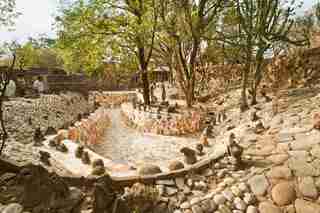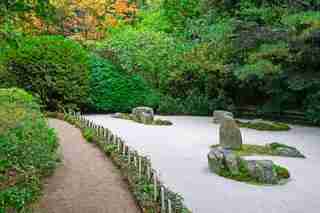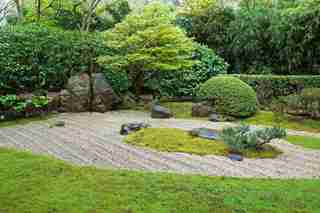Sometimes referred to as Zen gardens or dry landscapes, rock gardens have existed in China and Japan since at least the eighth century. They typically use the same elements—rocks, moss, gravel, and sand—each with an arrangement unique to its environment and the perspective of its designer. Today rock gardens run the gamut from traditional and austere to more playful interpretations with added color or unexpected arrangements. One common thread is their regard for the natural beauty of rocks and the serenity they inspire, coupled with the contemplative nature of the patterns and shapes that are created with just a little human intervention. What follows is a selection of some of the most renowned rock gardens, from centuries-old examples in Japan to more modern renditions around the world.

India’s Rock Garden at Chandigarh was secretly built on a land reserve by Nek Chand Saini, a city roads inspector, between 1957 and 1975, when it was discovered by authorities. Today the 40-acre site with statues and waterfalls is one of the city’s main attractions, along with Le Corbusier’s nearby civic buildings.

The Asticou Azalea Garden on Mount Desert Island, Maine, is home to this sand garden designed by Charles K. Savage. Composed of rocks and raked sand, the garden alludes to a nearby stream and complements the surrounding plants from the collection of island resident and renowned landscape architect Beatrix Farrand.

The Japanese Tea Garden in San Francisco is home to this Zen Garden by landscape architect Nagao Sakurai, who adhered to traditional Japanese guidelines, such as using pale gray stones. The garden was installed in 1953, the same year Sakurai was commissioned to renovate the site’s teahouse and gift shop.
Tenshin-en , or the Garden of the Heart of Heaven, at the Museum of Fine Arts, Boston, was installed in 1988 by landscape architect Kinsaku Nakane. The site, designed using more than 200 stones, was restored in 2015 by landscape designer Julie Moir Messervy and some of Nakane’s original team members.
An installation at the 2014 International Garden Festival in Quebec, This Rocks! Get Lost! is a garden made with pieces of marble from a Vermont quarry and native evergreens. Designed by New York landscape architecture firm Michael Van Valkenburgh Assoc., the garden is meant to conjure feelings of discovery.
This rock garden at Komyo-in, a temple in Kyoto, Japan, was created in 1939 using stones, moss, and raked gravel. The garden is located at the entrance to the temple, which is part of a larger complex at Tofuku-ji, one of the country’s best-known Buddhist temples.
The Garden of the Dragon, one of the three Zen gardens at the Ryogin-an sub-temple of Tofuku-ji, was designed in 1964 by landscape architect Shigemori Mirei. Unlike other rock gardens, this one includes both dark and light gravel—the dark sections are meant to represent the eponymous dragons.
The rock garden at Myoren-ji, a Buddhist temple in Kyoto, features a traditional arrangement of stones, moss, and sand, while the perimeter includes rhododendrons and pine trees. The temple, destroyed twice by fires and reconstructed in its current incarnation in 1789, offers lodging for visitors year-round.
Owned and cared for by a jewelry company in Yamanashi, Japan, the Jewel Dream Garden features a surprising arrangement using local multicolor crystals. The garden serves to promote the nearby Shingen Village Jewel Museum, owned by the same company.
Designated a national historic site, the rock garden at the Kodai-ji temple in Kyoto was designed by Japanese artist and tea master Kobori Enshu in the early 1600s. Located near the Higashiyama Ryozen mountain range, the garden is distinctive for its conical mounds of gravel.
